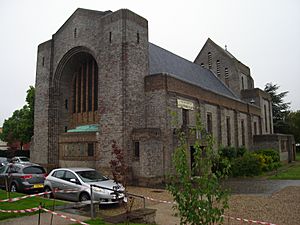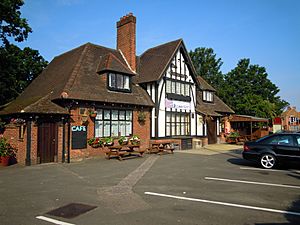Mile Cross Estate, Norwich facts for kids
The Mile Cross Estate is a special neighborhood in Norwich, England. It's known as a council estate, which means it's a large area with homes built by the local government to provide affordable housing for families. In 2011, about 10,655 people lived in the Mile Cross area of Norwich.
Contents
Where is Mile Cross?
This neighborhood is shaped a bit like a triangle and is about 2 miles (3.2 km) northwest of the center of Norwich. It has main roads on its sides: Aylsham Road to the east and Drayton Road to the west. To the north, you'll find Boundary Road and Mile Cross Lane. A road called Mile Cross Road runs right through the middle of the estate, from north to south.
History of Mile Cross
Mile Cross was one of the very first housing estates built in Norwich. It was created in the 1920s as part of a big plan called Homes fit for heroes. This plan aimed to build good quality homes for soldiers returning from World War I.
The design of Mile Cross was based on "garden suburb" ideas. This means it was planned to have lots of green spaces, gardens, and a community feel, not just rows of houses. A town planner named Professor Adshead helped design it, along with four important local architects: Stanley Wearing, A F Scott, George Skipper, and S J Livock.
From the start, Mile Cross was designed to be a complete community. It included everything people needed, like schools, churches, shops, places to meet, and open areas for everyone to enjoy.
Mile Cross: A Special Area
On January 2, 1979, most of the Mile Cross Estate was named a "conservation area". This means it's a special place where the buildings and history are protected. The conservation area covers about 163 acres (66 hectares).
This protected area is divided into four main parts:
- Area A was the first part built. It has streets like Losinga Crescent and Suckling Avenue. The houses here look like classic Georgian designs.
- Area B was the second part. It includes Margaret Paston Avenue and Oxnead Road. These homes use more different materials, like tile roofs and decorative wood frames that look like old Tudor styles.
- Area C was made bigger to include four important buildings: St Catherine's Church, its church hall, the vicarage (where the church leader lives), and the Mile Cross library.
- Area D also includes some newer homes that aren't as old or historically important.
Important Buildings and Places
St. Catherine's Church is a very notable building in Mile Cross. It was built between 1933 and 1935 by architects Caroe and Robinson. People describe it as a mix of old Romanesque and modern styles. It has a powerful inside, impressive details, and looks very grand. The church is made of buff-brown and grey-purple bricks and was given a special "Grade II*" listing in 2006, meaning it's a very important historic building. The church hall next to it is also listed as Grade II, and the vicarage is important locally. The Mile Cross library nearby is also worth seeing.
At three corners of the estate, you can find three well-known buildings: the old Galley Hill public house (which is now a hair and beauty salon) and the Boundary public house. Also, at the corner of Mile Cross Road and Drayton Road, there are shopping areas built with red bricks and pantiles (a type of roof tile).
Parks and Green Spaces
Mile Cross has several open green spaces. One of these is Mile Cross Gardens, which opened in May 1929. It was designed by Captain Sandys-Winch, who was the Parks Superintendent. This park is also listed as Grade II, and it still has some of its original features, like concrete shelters.
Many of the main roads in Mile Cross are lined with different kinds of trees. You can see large trees like horse chestnut, lime, and plane trees. On smaller, quieter roads, there are medium and smaller decorative trees, such as robinia and sorbus trees.
Street Names in Mile Cross
Many of the streets in Mile Cross are named after important people and places from local history. Here are a few examples:
- William Appleyard was Mayor of Norwich six times in the early 1400s. His old house is now the city's Bridewell Museum.
- Thomas Bignold started the Norwich Union insurance company.
- Luke Hansard was a printer whose name is now used for the official records of Parliament, called Hansard.
- Herbert Losinga was the very first Bishop of Norwich.
- Margaret Paston lived in the 1400s. Her letters are a great way to learn about life in Norfolk during that time.
- Walter Rye was Mayor of Norwich from 1908 to 1909 and wrote many books about Norfolk history.



